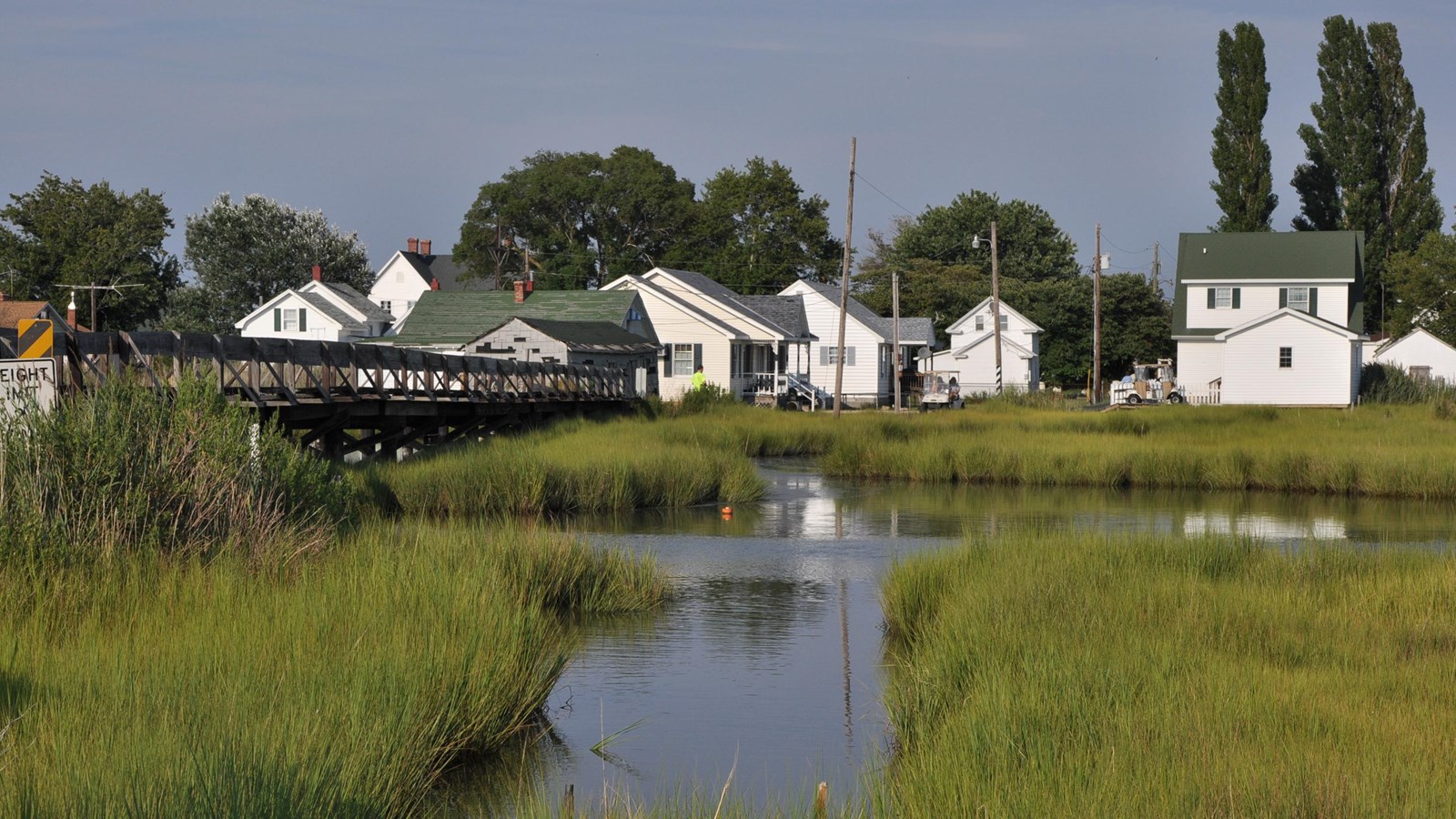Last updated: April 30, 2025
Place
Tangier Island

NPS / Copping
Beach/Water Access, Benches/Seating, Bicycle - Rental, Boat Ramp, Canoe/Kayak/Small Boat Launch, Dock/Pier, Ferry - Passenger, Food/Drink - Restaurant/Table Service, Gifts/Souvenirs/Books, Groceries/Convenience Items, Historical/Interpretive Information/Exhibits, Information, Internet/WiFi Available, Restroom, Scenic View/Photo Spot, Supplies - General, Water - Drinking/Potable
A Small Island With a Storied Past
Tangier is a low-lying island, barely visible above the expansive waters of the Chesapeake Bay. However, this small island is home to a community of watermen and women whose ancestors have lived here since colonial times. Surprising stories emerge from the island's history, from the Native Americans who came here to hunt and fish to the enslaved African Americans who escaped to the island to find their freedom.
Visiting Tangier
Tangier Island is only accesible by private boat or ferry. Catch a ferry from one of these locations:
Onancock, Virginia (Eastern Shore)
Reedville, Virginia (Western Shore)
Chrisfield, Maryland (Eastern Shore)
Find detailed information about ferry rides here.
Visit the Tangier Island website for a comprehensive guide to travel, lodging, ammenities, and activities available on the island.
Learn about the TANGIER ISLAND HISTORY MUSEUM here.
Tangier's History
Native Americans on Tangier
Shell middens, or waste piles of oyster shells, and many stone points discovered on the island reveal that Indigenous peoples visited Tangier Island. They likely came here to take advantage of the summer's rich bounty of fish and shellfish.The Pocomoke people of the Bay's Eastern Shore were among the groups that could have traveled here. They would have reached the offshore island in dugout canoes, the largest of which could reach 70 feet long.
Colonial Settlement
Among the first Europeans to observe the island, John Smith and his crew spotted Tangier and its neighboring islands during their voyage throughout the Bay in the summer of 1608. With a penchant for naming the places he visited, Smith called the islands the Russell Isles, after a member of his crew, Doctor Russell. As early as the 1670s, colonists held patents to the island, which they primarily used to graze livestock. A century later, the first permanent residents arrived on the island. At first they made their living by farming, but fishing, crabbing, and oystering soon took over as their primary occupation.
War of 1812
For nearly 1,000 slaves during the War of 1812, Tangier Island was a fortress of salvation, and the place where they took their first free steps. Fort Albion, named after the ancient name for England and Commodore George Cockburn’s flagship, was constructed on the island in 1814 to serve two major functions: as a central base to sustain continued British attacks along the Chesapeake, and as a depot for receiving runaway American slaves into citizenship and service to His Majesty, King George III of England.
Using America’s slaves against itself was not a novel idea – the British successfully employed this war tactic during the Revolutionary War. However, in the War of 1812, American slaves were considered free British citizens as soon as they set foot on British soil (which included forts and vessels), as slavery was illegal in all British territories. The new recruits remained neither American nor enslaved in the eyes of the British. Some slaves stole boats or canoes and met British troops directly; others started fires to get the attention of British soldiers for rescue. In some cases, these slaves took up arms as part of an active offense, while in others they simply took the opportunity presented by the British to escape bondage.
As early as 1813, British army and navy officers were instructed to “provide shelter, protection, and evacuation to refugees.” Admiral Alexander Cochrane formalized the policy in April 1814, with a proclamation offering the “choice of either entering into His Majesty’s Sea or Land Forces, or of being sent as FREE Settlers to the British Possessions in North America or the West Indies.”
With an anticipated influx of new recruits, the Royal Navy needed a new base. Tangier Island provided an easy access point in the Chesapeake to the Upper and Lower Bays, as well as the Potomac, Washington and Baltimore, while being surrounded by slaves in the plantation country of Virginia and Maryland. Fort Albion included a barracks, a hospital, a church, family dwellings and gardens, meant to accommodate not just prospective soldiers, but the families they brought with them as well. From its earliest inception, Fort Albion was conceived not just as a place for military training, but a place which would be a temporary home for newly freed Britons.
Tangier Island was not employed long; the War of 1812 ended less than a year after Fort Albion was built, on February 17, 1815. As the British withdrew, Cockburn ordered that “on no account [is] a Single Negro [to] be left, except by his own request,” fully embracing the status of the former slaves – whether in service or not – as free subjects of the British Empire. On March 21, 1815, the evacuation of the British from the island was completed, and Fort Albion and its barracks were burned. Former slaves were sent as soldiers and citizens to settle British colonies in the Caribbean and Canada.
Between the fort’s intentional destruction and subsequent unintentional destruction by storms and floods common in the Chesapeake, nothing remains of Fort Albion today. Much of Tangier Island where it stood has eroded, leaving a sandy beach reminiscent of those that slaves saw as they set foot on the island, in search of freedom.
